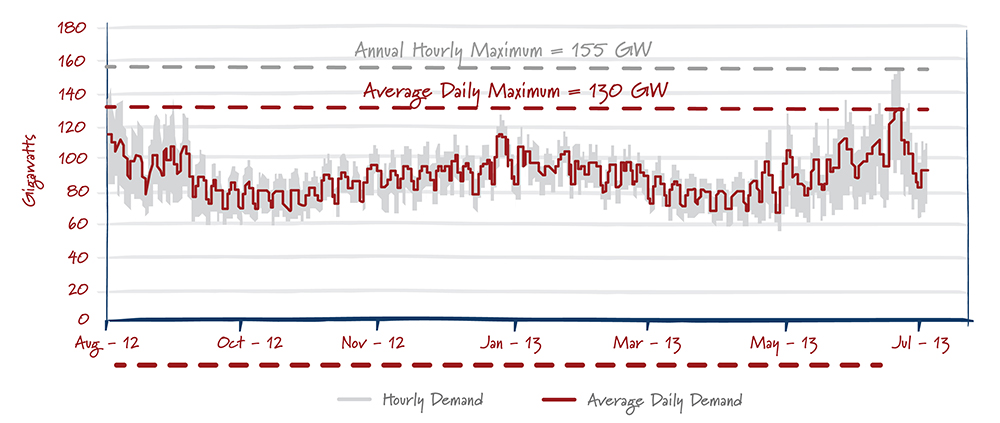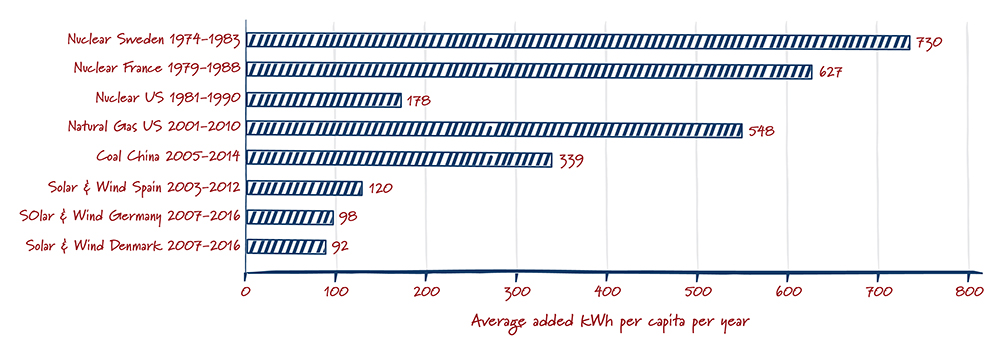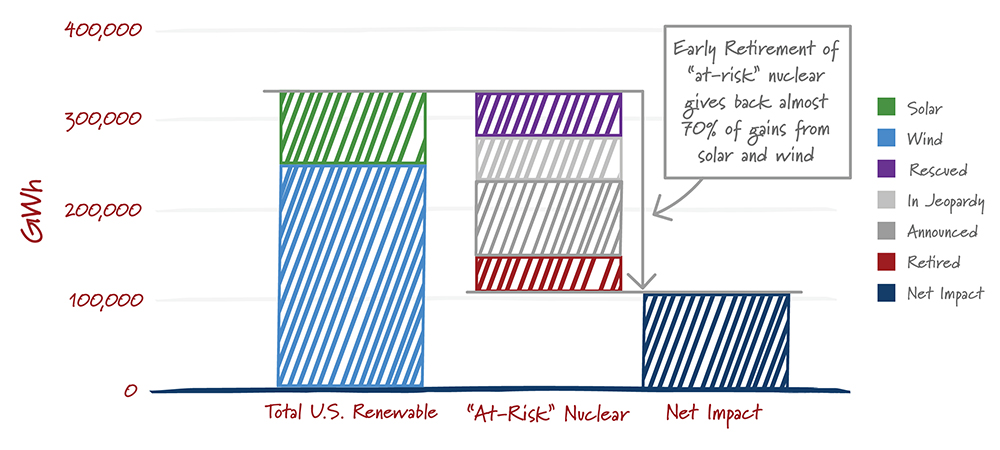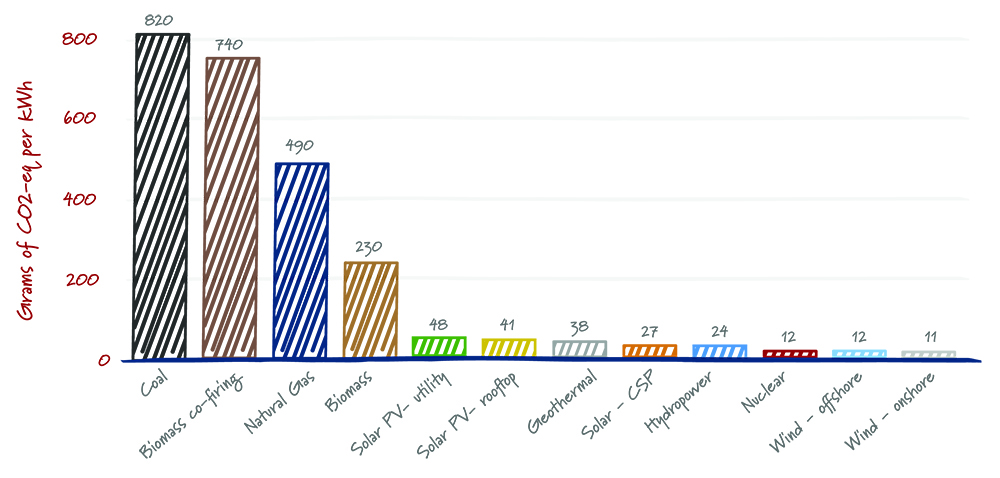This brief argues that a more comprehensive and aggressive strategy is to focus on carbon emissions and allow all proven low-carbon emitting technologies to play a role.1 Specifically, nuclear energy must be considered alongside solar, wind and hydro as leading sources of low-emission power. A more expansive view of clean energy, grounded in a clear-eyed understanding of the needs of the modern electricity grid and of the distinct characteristics of different generation technologies, will produce not only greater environmental benefits, but also a more resilient, reliable and affordable electricity system. The scale of the environmental challenge demands that we continue developing and improving on a range of low-carbon options, not just one or two technologies. Environmental and energy experts agree that without a diversity of options it will be much more difficult, if not impossible in economic and in practical terms, to meet rising world demand for electricity while substantially reducing global carbon emissions.
The key elements of this argument for a technology-neutral approach can be distilled to three broad points:
The remainder of this brief delves into each of these core points in turn. We close by highlighting the leadership role that corporations can play in advancing a better informed, more pragmatic and ultimately more effective strategy for achieving our clean energy and environmental goals. However, the same logic applies to public policy goals.

A power system that pairs dispatchable nuclear power with variable renewables can achieve far lower carbon emissions than a system that relies on other complementary sources for wind and solar. Modeling analyses and real-world experience reinforce this point. In the United States, natural gas has reshaped the electricity landscape for the better. Since the beginning of the natural gas boom, the United States has been able to increase its GDP while decreasing its carbon emissions, in large part because of natural gas. However, while natural gas is cleaner than coal or oil, it still has higher carbon emissions than nuclear. The power systems that are achieving the lowest emissions per kilowatt-hour are those that combine nuclear and renewables, such as France, Finland and the Canadian province of Ontario.2 By comparison, systems that have eschewed nuclear power have incurred higher emissions and higher costs. Indeed, when nuclear power plants are closed they are almost always replaced by natural gas.3 In some cases, nuclear closures have been replaced with coal. Germany, which made a substantial commitment to wind and solar and nuclear closure, has had to add generating stations that burn brown coal to replace its missing nuclear and balance its renewables. As a result, Germany hasn’t lowered its greenhouse gas emissions for nine years.4 Germany recently announced that they will phase out their remaining coal plants by 2038 to come closer to meeting climate targets, but they also intend to close their remaining nuclear plants by 2022, which will slow or prevent their climate progress.
A substantial expansion of renewables capacity, if it accelerates nuclear plant retirements, could result in higher system emissions. Variable renewables create grid management challenges not only because they are sometimes unavailable, but also because they are prone to generating excess supply when weather conditions are favorable. This can increase system costs (California, for example, has had to pay neighboring states like Arizona to take its surplus solar, while simultaneously importing nuclear power from Arizona) and depress wholesale electricity prices in ways that drive out other low-carbon resources and reduce the efficiency of the system as a whole. A recent analysis of least-cost options for achieving carbon reductions in the Pacific Northwest by Energy and Environmental Economics, Inc.5 found that policies such as renewable portfolio standards (RPS), which mandate a minimum percentage of wind and solar, have “unintended consequences such as oversupply and negative wholesale electricity prices that create challenges for reinvestment in existing zero-carbon resources.” By contrast, “a policy that encourages the retention of zero-carbon generation sources will help contain costs of meeting carbon goals.”
The more ambitious the carbon-reduction target, the greater the need for dispatchable low-carbon emitting options such as nuclear. Because variable renewables require additional power sources and other measures to ensure grid stability, relying almost exclusively on wind and solar to achieve deep emission reductions—while perhaps theoretically possible—would be both costly and technically challenging if grid operators don’t also have access to dispatchable low-carbon generators. A recent MIT study analyzed the cost of achieving specific carbon-reduction goals in a sample of electricity systems around the world using different cost assumptions for nuclear power.6 It found that excluding nuclear power altogether resulted in far higher system costs—moreover, these cost impacts increased dramatically under very tight emissions constraints. Similarly, a detailed modeling study of a Texas-like power system found that the optimal share of variable renewables—even in a geographic region that is favorable to wind and solar and even with available long-duration energy storage—actually shrinks at decarbonization targets above 80% (Figure 2).7 Surveying the current research on this issue, MIT’s Jesse Jenkins and Sam Thernstrom of the Energy Innovation Reform Project offer a succinct conclusion: “There is strong agreement in the literature that a diversified mix of low-CO2 generation resources offers the best chance of affordably achieving deep decarbonization.”8

Large-scale, long-duration energy storage could help address the limitations of variable renewables, and carbon capture and storage could enable continued use of fossil fuels. But it is best to maintain all options. Energy storage, in particular, is often viewed as a potential game changer for renewables, but a recent paper that examined its potential role in California, Wisconsin and Germany concluded on a cautionary note: “Wind and solar output exhibit seasonal episodes of both sustained oversupply and undersupply that overwhelm any conceivable storage strategy. Battery storage technologies may have a role in managing shorter-term imbalances but are unlikely to solve the very large seasonal swings in generation output under high-penetration IR (Variable Renewable) scenarios.”9 Counting on energy storage alone to enable a renewables-only strategy for deep decarbonization, in other words, is risky and potentially quite costly. Current lithium-ion systems that are rapidly coming down in cost are highly useful for flexible power applications, but are unsuitable for long-duration storage necessary to seasonally balance penetrations of solar and wind above 80% of annual generation.
Given these realities, and given the scale and timing of emission reductions needed to address climate change in this century, we don’t have the luxury of taking proven low-carbon technologies off the table before new alternatives emerge. Besides nuclear, hydropower is the only dispatchable low-carbon resource that is already playing a major role in the domestic and global power mix. But further large-scale opportunities to expand hydropower are somewhat limited by ecological and geographic constraints, as well as permitting. Nuclear facilities, by contrast, can be located in a wide range of settings and history has shown that nuclear capacity can be added quickly and in large increments if needed. In the second half of the 20th century, several countries successfully pursued aggressive nuclear deployment programs. In fact, a recent MIT analysis concluded that "historically, large-scale increases in low-carbon generation have occurred most rapidly in connection with additions of nuclear power."10

Today, despite nearly a decade of rapid growth in wind and solar deployment, nuclear is still the largest source of low-carbon emitting electricity generation in the United States. Nuclear energy accounts for more than half (56%) of the carbon-free electricity generated in the United States, and approximately 30% worldwide.11 Most of the non-nuclear carbon-free generation comes from hydroelectric power. Despite recent plant closures in the United States and elsewhere, nuclear also remains an important part of the overall electricity mix: it accounted for nearly 20% of U.S. generation in 2016, compared to less than 9% for wind and solar. Worldwide, nuclear accounted for 11% of overall electricity generation in 2016 (compared to 8% for non-hydropower renewables including waste).12

The continued retirement of existing nuclear power plants will significantly set back near-term efforts to reduce power sector carbon emissions. It also risks losing the operating experience and nuclear systems expertise needed to preserve nuclear as a low-carbon option for the future. The potential emissions impact of losing existing nuclear plants in the United States is enormous, especially since natural gas, which while cleaner than coal is still a higher in emissions than nuclear, has largely compensated for plant retirements to date. Operators of another 12 U.S. reactors have announced plans for premature shutdowns. The five reactors announced for closure in Ohio and Pennsylvania alone generate more emissions-free electricity than all wind and solar generators across the PJM regional transmission organization footprint, which includes part or all of 13 states (Figure 5). In fact, it’s estimated that early nuclear retirements in the United States have wiped out a large portion of the gains made by expanded renewables (Figure 6). If climate change is a real threat, shouldn’t we be doing everything we can to preserve what nuclear we have? (see Figure 5). Advanced nuclear reactors are under development for deployment beginning in the mid 2020’s from a variety of vendors13, and much of their success will depend on maintaining a viable nuclear industry.


While there are some concerns with geopolitics of uranium mining,14 potential supply vulnerabilities associated with large-scale renewables deployment have been similarly overlooked in many energy policy discussions to date. Cobalt and other rare earth minerals, for example, are a major component in lithium-ion batteries, solar panels and wind turbines. The Economist recently published several articles raising concern about an anticipated spike in global demand for cobalt in light of the fact that the lion’s share of this metal is mined in the highly-unstable Democratic Republic of the Congo.15 Natural gas also has some supply limitations. Thanks to the recent expansion of shale gas resources in the United States, natural gas has been relatively cheap and abundant for several years. But given the price volatility that has affected gas markets in the past, there are reasons to be cautious about expanding the U.S. power sector’s already substantial reliance on a single fuel.16


Cost has become a challenge for the nuclear industry over the last decade as existing U.S. plants, following a period of strong profitability for much of the 2000s, have struggled to compete in an environment of persistently low natural gas prices, slow demand growth and policies designed to favor renewable technologies. That includes state and federal subsidies that have not been available to nuclear plants.17 The cost of generating nuclear electricity is being driven down. The total generating cost of nuclear has fallen 19% since 2012. Clearly, the industry is continuing to work to reduce costs. But its cost challenges should not be compounded by the failure of markets to value its zero-emission attribute and nuclear energy’s real climate benefits. Additionally, allowing nuclear to compete on a level playing field with other low-carbon resources would deliver near and long-term environmental benefits, and help ensure that this technology can continue to play a role.

Regarding safety, the U.S. fleet of 98 operating reactors has amassed a record of exemplary reliability and performance. In this country and elsewhere, the industry is highly regulated and subject to exacting safety standards.18 And rightly so, nuclear power can have impacts and consequences that are fundamentally different from other generation sources. Since the dawn of the nuclear age in the 1950s, the global nuclear industry has experienced only three serious reactor accidents. New reactor designs incorporate redundant passive safety features and hold promise for further improving performance and reducing accident risks. Two additional points regarding safety and public health are worth underscoring: First, any balanced assessment of risks must also take into account the risks associated with other generation options, as well as the downside risks of failing to address climate change. Second, some of the strongest support for nuclear energy can be found in communities that have had long experience with hosting nuclear facilities. This suggests that public perceptions can evolve with more familiarity with the technology and a better understanding of the trade-offs involved. Regarding waste, the U.S. government’s failure to develop a permanent repository for used nuclear fuel and other nuclear waste has been deeply frustrating. It must be emphasized, however, that there are technical solutions to nuclear waste. Every expert study that has looked at the waste issue has concluded that it is technically and scientifically feasible to manage and provide for the safe, permanent disposition of these materials.19 Other nations have successfully identified permanent repository sites and have begun developing the facilities to handle and dispose of nuclear waste, or to recycle it for reuse. The U.S. must find a practical solution to make good on the government’s waste management obligations as soon as possible. In the meantime, current methods for storing used fuel at reactor sites—first in cooling pools and then in dry casks made of concrete and steel—are highly robust. In fact, the U.S. Nuclear Regulatory Commission has determined that used fuel can be safely managed for well more than 100 years at existing plant sites.20
Advanced reactor designs hold promise for improving safety, simplifying plant operations and potentially expanding the use of nuclear energy to industrial heat applications as a way to achieve carbon reductions in other sectors of the economy. Established companies as well as entrepreneurial startups backed by venture capital have continued to invest in new nuclear technologies, including improved, traditional gigawatt-scale designs, small modular reactors (50- to 300-megawatt range) and micro-reactors for remote or other off-grid locations. Many of these designs offer significant potential advantages such as waste reduction, increased flexibility21 and ease of operation. Innovators understand that the next generation of nuclear technologies must compete in a very different, highly cost-competitive environment. Including nuclear in clean energy policies is critical to building confidence in future markets for these technologies and to justify continued investment in nuclear innovation.
In sum, the magnitude of the climate and energy challenge is hard to overstate. Any effort to deeply decarbonize our energy system is going to require that electricity generation be virtually carbon-free. And without nuclear, we simply can’t get there from here. In the United States and around the world, demand for all forms of energy, and for electricity in particular, continues to grow. The International Energy Agency (IEA), for example, projects that global energy needs, while not growing as rapidly as in the past, will still increase by 30% between 2017 and 2040. As the IEA points out, “This is the equivalent of adding another China and India to today’s global demand.”22 Global electricity production is expected to increase even more over the same period, by as much as 45%.23
At the same time, climate scientists are warning that rapid progress toward reducing global carbon emissions is needed to achieve widely-held climate stabilization goals. Most experts agree that decarbonizing the power sector is the place to start, given the dearth of readily substitutable low-carbon fuel alternatives in other sectors. Electrification of sectors like transportation may also be an important part of a long-term climate mitigation strategy, but this will further increase electricity demand and further raise the stakes for decarbonizing the power mix. Meanwhile, current projections imply that the world will have to add thousands of gigawatts of new electricity generating capacity over the next several decades. To add this capacity while still dramatically shrinking the power sector’s overall carbon footprint will require a daunting combination of sound policy; strong public, political and corporate support; and massive infrastructure investments—all in the span of a few short decades. Given this set of challenges in this timeframe, there is no realistic path forward that does not include all the low-carbon generation options, including nuclear energy, that are available to us today.
